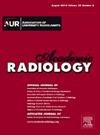预测微波消融后小肝细胞癌肿瘤残留的提名图
IF 3.8
2区 医学
Q1 RADIOLOGY, NUCLEAR MEDICINE & MEDICAL IMAGING
引用次数: 0
摘要
依据和目的:本研究试图建立一个预测肝细胞癌患者微波消融术后消融效果的提名图,从而指导小肝细胞癌微波消融术的选择:在这项双中心回顾性研究中,共纳入了233例2016年1月至2023年12月期间接受微波消融术(MWA)治疗的肝细胞癌患者,并分析了他们的临床基线数据、实验室参数和磁共振成像特征。采用逻辑回归分析筛选特征,并分别建立了临床和影像特征模型。最后,建立了一个提名图。使用曲线下面积(AUC)、准确性、灵敏度、特异性和决策曲线分析(DCA)对所有模型进行了评估:根据训练集(n = 182,包括完全消融:136,不完全消融:46)和外部验证集(n = 51,完全消融:36,不完全消融:15),建立了两个模型和一个提名图,用于预测 MWA 后的消融结果。临床模型和提名图在外部验证组中表现良好。提名图的 AUC 为 0.966(95% CI:0.944- 0.989),灵敏度为 0.935,特异度为 0.882,准确度为 0.896:结合临床数据和影像学特征,构建的提名图能有效预测接受 MWA 的肝细胞癌患者的术后消融结果,有助于临床医生为肝细胞癌患者提供治疗方案。本文章由计算机程序翻译,如有差异,请以英文原文为准。
Nomogram to Predict Tumor Remnant of Small Hepatocellular Carcinoma after Microwave Ablation
Rationale and Objectives
This investigation sought to create a nomogram to predict the ablation effect after microwave ablation in patients with hepatocellular carcinoma, which can guide the selection of microwave ablation for small hepatocellular carcinomas.
Methods
In this two-center retrospective study, 233 patients with hepatocellular carcinoma treated with microwave ablation (MWA) between January 2016 and December 2023 were enrolled and analyzed for their clinical baseline data, laboratory parameters, and MR imaging characteristics. Logistic regression analysis was used to screen the features, and clinical and imaging feature models were developed separately. Finally, a nomogram was established. All models were evaluated using the area under the curve (AUC), accuracy, sensitivity, specificity, and decision curve analysis (DCA).
Results
Two models and a nomogram were developed to predict ablation outcomes after MWA based on a training set (n = 182, including complete ablation: 136, incomplete ablation: 46) and an external validation set (n = 51, complete ablation: 36, incomplete ablation: 15). The clinical models and nomogram performed well in the external validation cohort. The AUC of the nomogram was 0.966 (95% CI: 0.944- 0.989), with a sensitivity of 0.935, a specificity of 0.882, and an accuracy of 0.896.
Conclusions
Combining clinical data and imaging features, a nomogram was constructed that could effectively predict the postoperative ablation outcome in hepatocellular carcinoma patients undergoing MWA, which could help clinicians provide treatment options for hepatocellular carcinoma patients.
求助全文
通过发布文献求助,成功后即可免费获取论文全文。
去求助
来源期刊

Academic Radiology
医学-核医学
CiteScore
7.60
自引率
10.40%
发文量
432
审稿时长
18 days
期刊介绍:
Academic Radiology publishes original reports of clinical and laboratory investigations in diagnostic imaging, the diagnostic use of radioactive isotopes, computed tomography, positron emission tomography, magnetic resonance imaging, ultrasound, digital subtraction angiography, image-guided interventions and related techniques. It also includes brief technical reports describing original observations, techniques, and instrumental developments; state-of-the-art reports on clinical issues, new technology and other topics of current medical importance; meta-analyses; scientific studies and opinions on radiologic education; and letters to the Editor.
 求助内容:
求助内容: 应助结果提醒方式:
应助结果提醒方式:


